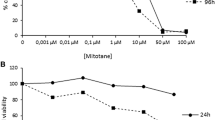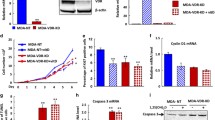Abstract
1,25-dihydroxyvitamin D3 [1,25(OH)2D3], the active metabolite of vitamin D, inhibits breast cancer cell growth both in vivo and in vitro. In addition to its anti-proliferative effects, 1,25(OH)2D3 induces morphological and biochemical markers of apoptosis in MCF-7 cells. In the studies reported here, we compared the effects of 1,25(OH)2D3 and EB1089, a low calcemic vitamin D analog, on cell cycle kinetics and apoptosis in MCF-7 cells. Both vitamin D compounds reduced viable MCF-7 cell number in a time and dose dependent manner, with EB1089 approximately 50 fold more potent than 1,25(OH)2D3. Flow cytometric analysis indicated that both agents induced cell cycle arrest in G0/G1 which was associated with accumulation of the hypophosphorylated form of the retinoblastoma (Rb) protein. MCF-7 cells treated with either 1,25(OH)2D3 or EB1089 for 48 h exhibited characteristics of apoptosis, including cytoplasmic condensation, pyknotic nuclei, condensed chromatin and DNA fragmentation. Cells treated with either agent exhibited up regulation of proteins associated with mammary gland regression (clusterin and cathepsin B) and down regulation of the anti-apoptotic protein bcl-2. These studies demonstrate that, despite its lower calcemic activity in vivo, the vitamin D analog EB1089 induces effects that are indistinguishable from those of 1,25(OH)2D3 on cell number, cell cycle and indices of apoptosis in MCF-7 cells in vitro. In addition, since both agents rapidly down regulate estrogen receptor, disruption of estrogen dependent signalling may play a role in the induction of apoptosis by vitamin D compounds in MCF-7 cells.
Similar content being viewed by others
References
Chouvet C, Berger U, Coombes RC: 1,25-dihydroxyvitamin D3 inhibitory effect on the growth of two human breast cancer cell lines (MCF-7, BT-20). J Steroid Biochem 24: 373–376, 1986
Colston K, Chander SK, Mackay AG, Coombes RC: Effects of synthetic vitamin D analogs on breast cancer cell proliferation in vivo and in vitro. Biochem Pharm 44: 693–702, 1992
Vink-van Wijngaarden T, Pols H, Buurman CJ, van den Bemd G, Dorssers L, Birkenhager J, van Leeuwen J: Inhibition of breast cancer cell growth by combined treatment with vitamin D3 analogues and tamoxifen. Cancer Research 54: 5711–5717, 1994
Welsh J, Simboli-Campbell M, Tenniswood M: Induction of apoptotic cell death by 1,25(OH)2D3 in MCF-7 breast cancer cells. In: Norman AW, Bouillon R, Thomasett M (eds) Proceedings of the Ninth Workshop on Vitamin D. Walter Degruyter & Co., Berlin, 1994
Welsh JE: Induction of apoptosis in breast cancer cells in response to vitamin D and antiestrogens. Biochem Cell Biol 72: 537–545, 1994
Simboli-Campbell M, Welsh JE: 1,25-dihydroxyvitamin D3: coordinate regulator of active cell death and proliferation in MCF-7 breast cancer cells. In: Tenniswood M, Michna H (eds) Schering Foundation Workshop, Vol. 14: Workshop on Apoptosis in Hormone Dependent Cancers. Springer Verlag, Berlin p. 181–200, 1995
Kyprianou N, English H, Davidson N, Isaacs J: Programmed cell death during regression of the MCF-7 human breast cancer following estrogen ablation. Cancer Research 51: 162–166, 1991
Warri AM, Huovinen RL, Laine AM, Martikainen PM, Harkonen PL: Apoptosis in toremifene-induced growth inhibition of human breast cancer cells in vivo and in vitro. J Natl Cancer Inst 85: 1412–1418, 1993
Guenette RS, Corbeil H, Leger J, Wong K, Mezl V, Mooibroek M, Tenniswood M: Induction of gene expression during involution of the lactating mammary gland of the rat. J Mol Endo 12: 47–60, 1994
Binderup L, Latini S, Binderup E, Bretting C, Caverley M, Hansen K: 20 Epi-Vitamin D3 analogues: a novel class of potent regulators of cell growth and immune responses. Biochem Pharm 42: 1569–1575, 1991
Colston K, Mackay AG, James SY, Binderup L: EB1089: a new vitamin D analogue that inhibits the growth of breast cancer cells in vivo and in vitro. Biochem Pharm 44: 2273–2280, 1992
Colston K, Mackay AG, James SY: Vitamin D3 derivatives and breast cancer. In: Tenniswood M, Michna H (eds) Schering Foundation Workshop, Vol. 14: Workshop on Apoptosis in Hormone Dependent Cancers. Springer Verlag, Berlin, p. 181–200, 1995
James SY, Mackay A, Binderup L, Colston K: Effects of a new synthetic vitamin D analog, EB1089, on the oestrogen responsive growth of human breast cancer cells. J Endo 141: 555–563, 1994
Narvaez CJ, VanWeelden K, Byrne I, Welsh JE: Characterization of a vitamin D3 resistant MCF-7 cell line. Endocrinology 137: 400–409, 1996
James SY, Mackay A, Colston K: Vitamin D derivatives in combination with 9-cis retinoic acid promote active cell death in breast cancer cells. J Mol Endo 14: 391–394, 1995
Bellomo G, Perotti M, Taddei F, et al.: Tumor necrosis factor α induces apoptosis in mammary adenocarcinoma cells by an increase in intranuclear free calcium concentration and DNA fragmentation. Cancer Res 52: 1342–1346, 1992
Dowd DR, MacDonald PN, Komm BS, Haussler MR, Miesfield RL: Stable expression of the calbindin D28K complementary DNA interferes with the apoptotic pathway in lymphocytes. Mol Endocrinol 6: 1843–1848, 1992
Mezettie G, Monti MG, Casolo P, Piccinini G, Moruzzi MS: 1,25-dihydroxycholecalciferol dependent calcium uptake by mouse mammary gland in culture. Endocrinology 122: 389–394, 1988
Simboli-Campbell M, Miller M, Zhu XM, Franks DJ, Williamson DG: Modulation of a renal estrogen receptor by protein kinase C. Receptors and Channels 2: 33–40, 1994
Walker PR, Kwast-Welfeld J, Gourdeau H, Leblanc J, Neugebauer W, Sikorska M: Relationship between apoptosis and the cell cycle in lymphocytes: roles of protein kinase C, tyrosine phosphorylation and AP1. Experimental Cell Research 207: 142–151, 1993
Tenniswood M, Guenette RS, Lakins J, Mooibroek M, Wong P, Welsh JE: Active cell death in hormone dependent tissues. Cancer and Metastasis Reviews 11: 197–220, 1992
Tenniswood MP, Taillefer D, Lakins J, Guenette RS, Mooibroek M, Daehlin L, Welsh JE: Control of gene expression during apoptosis in hormone dependent tissues. In: Tomei LD, Cope FO (eds) Apoptosis: The Molecular Basis of Cell Death, Vol II. Cold Spring Harbor Laboratory Press, 283–311, 1994
Lanzerotti RH, Gullino PM: Activities and quantities of lysosomal enzymes during mammary tumor regression. Cancer Res 32: 2679–2685, 1972
Guenette RS, Mooibroek M, Wong K, Wong P, Tenniswood M: Cathepsin B, a cysteine protease implicated in metastatic progression, is also expressed during regression of the rat prostate and mammary glands. Eur J Biochem 226: 311–321, 1994
Reed JC: Bcl-2 and the regulation of programmed cell death. J Cell Biol 124: 1–6, 1994
Craig RW: The BCL-2 gene family. Seminars in Cancer Biology 6: 35–43, 1995
Wang TTY, Phang JM: Effects of estrogen on apoptotic pathways in human breast cancer cell line MCF-7. Cancer Research 55: 2487–2489, 1995
Sumantran VN, Ealovega MW, Nunez G, Clarke MF, Wicha MS: Overexpression of Bcl-xs sensitizes MCF-7 cells to chemotherapy induced apoptosis. Cancer Research 55: 2507–2510, 1995
Eisman J, Sutherland RL, McMenemy ML, Fragonas JC, Musgrove EA, Pang G: Effects of 1,25-dihydroxyvitamin D3 on cell cycle kinetics of T47D human breast cancer cells. J Cell Physiol 138: 611–616, 1989
Elstner E, Linker-Israeli M, Said J, Umiel T, deVos S, Shintaku IP, Heber D, Binderup L, Uskokovic M, Koeffler HP: 20-epi vitamin D3 analogues: a novel class of potent inhibitors of proliferation and inducers of differentiation of human breast cancer cells. Cancer Research 55: 2822–2830, 1995
Kobayashi T, Hashimoto K, Yoshikawa K: Growth inhibition of human keratinocytes by 1,25-dihydroxyvitamin D3 is linked to dephosphorylation of retinoblastoma gene product. Biochem Biophys Res Commun 196: 487–493, 1993
Yen A, Varvayanis S: Late dephosphorylation of the RB protein in G2 during the process of induced cell differentiation. Exper Cell Res 214: 250–257, 1994
Bonell D, Welsh J: Interaction of 1,25(OH)2D3 and TGFβ in IEC-6 cells. In: Norman AW, Bouillon R, Thomasett M (eds) Proceedings of the Ninth Workshop on Vitamin D. Walter DeGruyter & Co., Berlin, 1994
Demirpence E, Balaguer P, Trousse F, Nicolas JC, Pons M, Gagne D: Anti-estrogenic effects of all-trans retinoic acid and 1,25 dihydroxyvitamin D3 in breast cancer cells occur at the estrogen response element level but through different molecular mechanisms. Cancer Res 54: 1458–1464, 1994
Author information
Authors and Affiliations
Rights and permissions
About this article
Cite this article
Simboli-Campbell, M., Narvaez, C.J., VanWeelden, K. et al. Comparative effects of 1,25(OH)2D3 and EB1089 on cell cycle kinetics and apoptosis in MCF-7 breast cancer cells. Breast Cancer Res Treat 42, 31–41 (1997). https://doi.org/10.1023/A:1005772432465
Issue Date:
DOI: https://doi.org/10.1023/A:1005772432465




